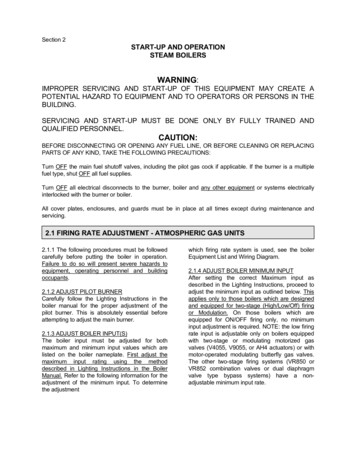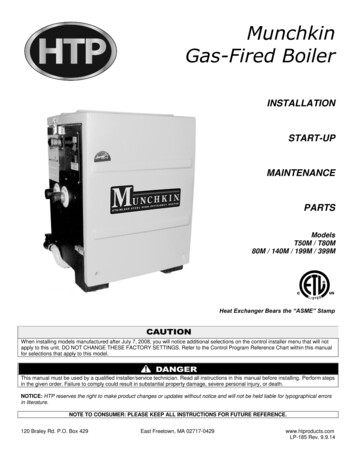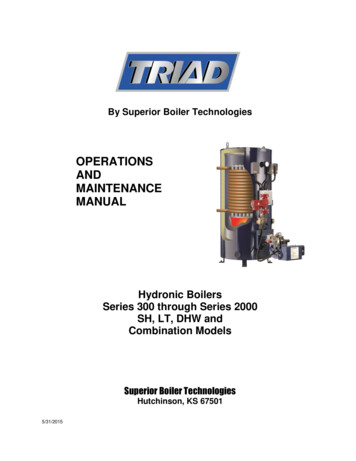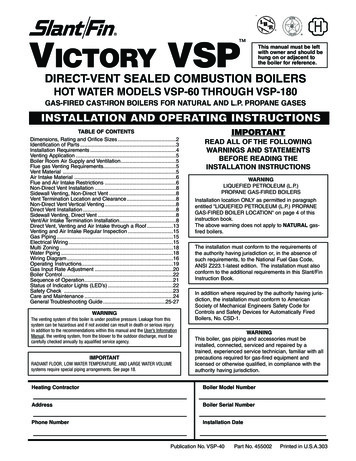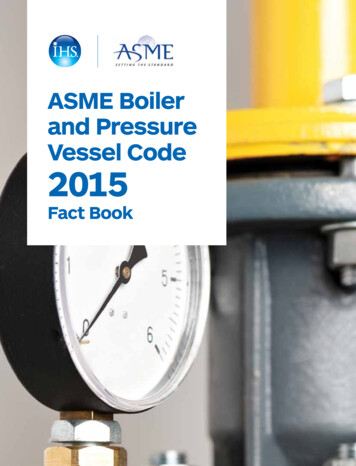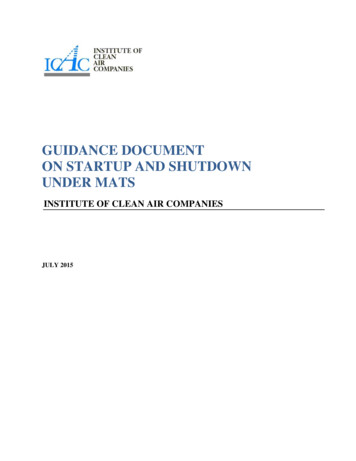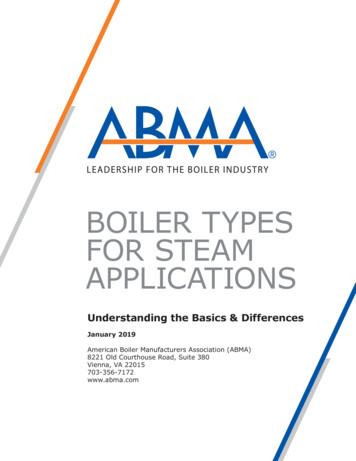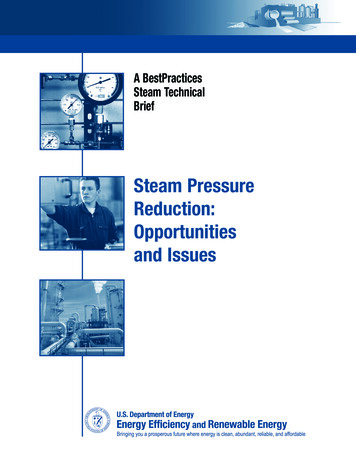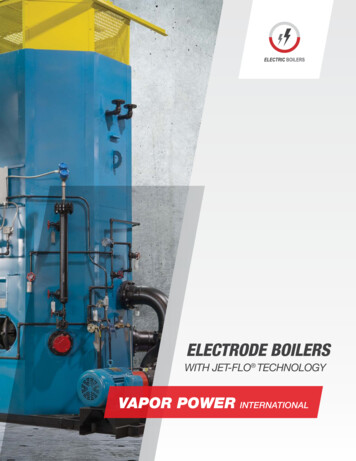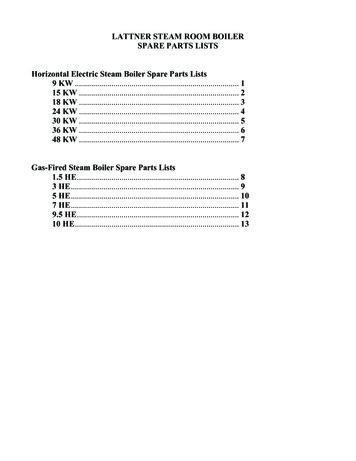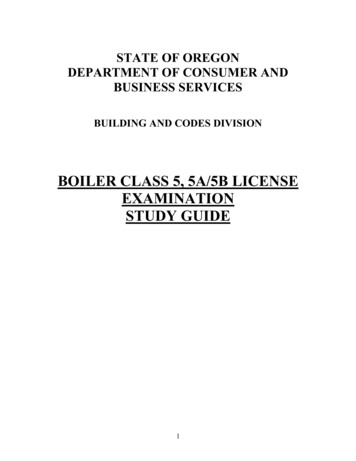
Transcription
STATE OF OREGONDEPARTMENT OF CONSUMER ANDBUSINESS SERVICESBUILDING AND CODES DIVISIONBOILER CLASS 5, 5A/5B LICENSEEXAMINATIONSTUDY GUIDE1
General Information for all LicenseesThe following study guide is to be used to assist you in preparing for the questions on the Stateof Oregon Boiler Licensing Exams. This is not an extensive listing of knowledge expected froma “Qualified Certified Person.” Where there are general discussions of ASME, NBIC, and NFPACode requirements or of Oregon Administrative Rules or statutes, the study guide is notcontrolling: the applicable code, rule or statute is the final authority.The exam questions are randomly selected from a set of over 400 questions that coveradministrative rules, ASME, NBIC and NFPA Codes, materials, math, drawing, repairs, physicalscience, safety, trade knowledge and welding for Class 4 and Class 5 candidates. The examquestions are based upon the knowledge and experience that is expected of candidates for theClass certification being attempted.The rules for licensing of persons installing, altering or repairing boilers or pressure vessels arelisted in ORS 480.630 through ORS 480.645. Requirements for each “Qualified CertifiedPerson” who can be licensed to install, alter or repair boilers, pressure vessels and pressurepiping in the State of Oregon are listed in OAR 918-225-0691. These consist of Class 2, Class 3,Class 4, Class 5, Class 5-A and Class 5-B. The Class 1 Trainee/Helper and Class 6 Welder arenot required to take and pass the Oregon Boiler License Exam to be certified. The exam coversthe Oregon Revised Statutes and the Oregon Administrative Rules for boilers and pressurevessels but this study guide does not cover those administrative rules. These administrative rulesmay be printed off the web site for review and are available on line ler.aspx Boiler Statutes: Oregon Revised Statutes (ORS) 480.510 to 480.670Boiler Administrative Rules: Oregon Administrative Rules(OAR)918-225-0220 through 918-225-0800The 2015 Oregon Boiler and Pressure Vessel Specialty Code containing the minimum safetystandards for boilers, pressure vessels, pressure piping, nuclear components, parts, items, andrepair and alteration procedures follow:(1) ORS 480.510 to 480.670 and OAR chapter 918, division 225;(2) The Boiler and Pressure Vessel Code of The American Society of Mechanical Engineers(ASME), 2013 Edition as published, including Section I; Section II, Parts A, B,C and D; SectionIV; Section V; Section VIII, Division 1, 2 and 3; Section IX; and Section X.(3) The 2012 Edition of the ANSI/ASME B31.1 Power Piping Code.(4) The 2012 Edition of the ANSI/ASME B31.3 Process Piping Code.(5) The 2013 Edition of the ANSI/ASME B31.5 Refrigeration Piping Code.(6)The 2011 Edition of the ANSI/ASME B31.9 Building Service Piping Code.2
(7) The 2013 Edition of the National Board Inspection Code (NBIC) ANSI/NB 23;(8) The 2011 Edition of NFPA 85, Boiler and Combustion Systems Hazards Code; and(9) The 2012 Edition of ASME CSD-1, Controls and Safety Devices for Automatically FiredBoilers.The ASME Codes listed above are “codes of construction” and list the allowable design,materials, construction and installation of Code items. The NBIC lists the installationrequirements and the permissible repairs to Code items.This study guide will summarize sections of the above codes and discuss trade practices to assistin passing the Boiler license exam. For a more complete understanding of the above Codes, referto the individual Code sections.Class 5Class 5 Pressure Piping Mechanic. A person holding this license may fabricate, install, alter andrepair pressure piping; install boilers and pressure vessels by attachment of piping connections;and install, assemble and repair cast iron sectional boilers. Applicants shall:1. Have a minimum of 2,000 hours of experience performing pipe-welding or brazing onB31 pressure piping and 2,000 hours of experience performing work on pressure piping.Experience must be verified as established in OAR division 30; and2. Pass an examination testing the applicant's knowledge of:A. American Society of Mechanical Engineers Boiler and Pressure Vessel Code,Sections I, II, IV, V, VI, VII, VIII, IX, CSD-1 and B 31 Pressure Piping;B. Structural and mechanical blueprints with the ability to interpret specifications;C. Pressure piping systems and controls;D. Boiler and Pressure Vessel Laws, ORS 480.510 to 480.665 and OAR chapter 918,division 225; andE. Welding, brazing, chemical bonding procedures, heat treatment, metallurgy andother procedures applicable to pressure piping systems.Class 5-AClass 5-A Process Piping Mechanic License. A person holding this license may fabricate, install,alter or repair B31.3 process piping. Applicants shall:3
1. Have a minimum of 2,000 hours of experience performing pipe-welding or brazing onB31.3 process piping and 2,000 hours of experience performing work on pressure piping.Experience must be verified as established in OAR division 30; and2. Pass an examination testing the applicant's knowledge of:A. American Society of Mechanical Engineers Boiler and Pressure Vessel Code,Section B31.3;B. Structural and mechanical blueprints with the ability to interpret specifications;C. Pressure piping controls;D. Boiler and Pressure Vessel Laws, ORS 480.510 to 480.665 and OAR chapter 918,division 225; andE. Welding, brazing, chemical bonding procedures, heat treatment, metallurgy andother procedures applicable to pressure piping systems.ASME B31.3 Category “M” piping is designated as lethal service piping. Category “M” piping isdesignated by the system owner and must be inspected by a Certified Process Piping Inspectorthat is employed by the piping system’s owner.All piping systems should be designed with consideration of vibration, thermal and seismicloadings.Class 5-BClass 5-B Refrigeration Piping Mechanic License. A person holding this license may fabricate,install, alter or repair B31.5 refrigeration piping. Applicants shall:1. Have a minimum of 2,000 hours of experience performing pipe-welding or brazingon B31.5 refrigeration piping and 2,000 hours of experience performing work onpressure piping. Experience must be verified as established in OAR division 30; and2. Pass an examination testing the applicant's knowledge of:A. American Society of Mechanical Engineers Boiler and Pressure Vessel Code,Section B31.5;B. Structural and mechanical blueprints with the ability to interpret specifications;C. Pressure piping controls;4
D. Boiler and Pressure Vessel Laws, ORS 480.510 to 480.665 and OAR chapter 918,division 225; andE. Welding, brazing, heat treatment, metallurgy and other procedures applicable topressure piping systems.Piping systems for refrigeration piping may utilize materials that meet the ASME B31.5 Code.These materials may be reclaimed provided the piping is properly identified. Bending and coldspringing to align pipe is allowed providing the finished piping surface is free of cracks andbuckles. Bell and Spigot type fittings may not be used. Toxic service fluids cannot use cast ormalleable iron fittings. Piping designs for exposed piping systems must include the effects ofwind loading. All pressure piping systems shall be designed for seismic loadings.ASME Section IX covers brazing requirements.A3 and B3 refrigerant piping butt and miter groove welds require both visual and 5%radiographic inspection.Pressure testing of refrigeration piping systems shall be at least 110% but not more than 130% ofthe system design pressure.Pressure Vessel InstallationsPiping AttachmentsFlanged Attachments- The bolts in a flanged connection must exhibit full threadengagement. This means that bolts shall engage so that the threading goes completely throughthe nut. Follow manufacturers’ recommendations when tightening flange bolts.Threaded fittings- Completed thread fittings must leave at least two threads exposed. Inaddition, different sized fittings have a minimum number of threads that must be engaged in thefitting. Minimum thread engagement in threaded fittings are as follows: Under 1-1/2” NPS4 threads 1-1/2” & 2” NPS5 threads 2-1/2” to 4” NPS7 threads 5” & 6” NPS8 threads 8” NPS10 threads 10” NPS12 threads 12” NPS13 threadsEXAMPLE: A 2” NPS fitting must have at least 5 threads engaged and must leave at least 2threads exposed.Piping Materials Piping materials for ASME applications must be listed in ASME Section II. ASME-listed piping materials must have identifying marks recording the piping type,manufacturer and heat numbers of the batch for traceability.5
When ASME piping materials are cut, the identifying numbers must be transferred to thecut pieces. Since coatings would make the identifying markers unreadable, painting priorto installation or galvanizing is not allowed.Some non-metallic piping, including plastic piping, is listed in ASME Section II and isallowed in ASME B31.9, Building Service Piping, but the use of PVC plastic pipe is notallowed.PVC piping may not be used because it may fracture under pressure and will becomebrittle when cold. In air compressors, PVC could be affected by compressor oils in theair stream.ASME B31.9, Building Service Piping covers piping systems operated at pressures up to150 psi.Used pipingUsed piping and piping fittings may only be used after thorough cleaning and inspection by anauthorized inspector. If identifying marks are not clearly visible, the inspector may requiremechanical and/or chemical testing to verify the composition of the material.Pressure testing of vessels and piping systemsLeak testing of pressure vessels and piping systems may be required by an inspector. The Tosafely pressurize a system for a leak test: the system’s pressure must be gradually increased to a required test pressure (provided bythe inspector) the test pressure must be maintained for a designated period of time, generally between10 to 20 minutes. If water is used to perform the leak test, the metal temperature must be at least 60oF toassure the vessel is not thermally stressed. For personnel safety, the temperature shouldnot exceed 120oF. If air or nitrogen is used to perform the leak test, the test will be performed at lowerpressures and must first be approved by an inspector. Air and nitrogen under pressurehave high kinetic energy and could create an explosion if there is a rupture.Piping weight and hydrotestsWhen installing piping, the additional weight that will be applied during a hydrotest must betaken into consideration. Even air piping must be installed so that it can bear the weight that willbe applied during a hydrotest. Thus, an installer must know the weight of the entire pipingsystem in order to properly design and select pipe supports and hangers.To know the weight of a section of pipe that is filled with water, you must know: The weight of the pipe per foot of run The volume inside the pipe The weight of the water required to fill that volumeFiguring out this information sometimes requires the use of basic math and the memorization ofsome basic facts about the weight of water and the volume of water within an area.6
Mathematical terms related to circles: CircumferenceDiameter RadiusFor the purposes of using math in the field, (pi) is rounded off to be 3.14You should also know how to convert fractions into decimals:To convert ¾ into a decimal, divide 3 by 4, which would give you .75You can use a calculator to do this, or you could do it long hand by adding a decimal point andzero to the top half of the fraction (dividing 3.0 by 4) and putting your answer to the right of thedecimal point your answer.½ .50 [1.0 2 .50]1/3 .333 [1.0 3 .333]4/5 .80 [4.0 5 .80]7/8 .875 [7.0 8 .875]Area of a circleThe formula for calculating the area of a circle is:Radius x Radius x 3.14 Area( r2 Area)Example- For a 6 inch diameter pipe, the radius equals one half of the diameter, 3 inches3 inches x 3 inches x 3.14 28.3 square inchesCircumference of a circleThe formula for calculating the circumference of a circle is:Diameter x 3.14 Circumference27
( d Circumference)Example- For a 6 inch diameter pipe,6 inches x 3.14 18.84 inches in circumferenceAlso, with pipes there are two circumferences: the inner circumference (the circle that is on the inside of the pipe) the outer circumference (the circle that is on the outside of the pipe)As pipes get larger there can be a substantial difference between the inner circumference and theouter circumference.To calculate the inner circumference you would use the diameter of the inside of the pipe.To calculate the outer circumference, your diameter would be the diameter from the insideof the pipe plus the thickness of the pipe.Example- The outer circumference of a ½” thick pipe with a 6 inch inner diameter would be:7 inches (6” inner diameter plus ½” thickness on both sides) x 3.14 21.98 inchesVolume of a cylinder (or pipe)The formula for calculating the volume of a cylinder is:Area x Length VolumeExample- For a 6 inch pipe with a 24 inch run (length):28.3 inches x 24 inches 679.2 cubic inches of volumeCalculating gallons of water per cubic inchThe formula for knowing how much water is in a volume of pipe is:One gallon of water 231 cubic inches of pipingWe know from the previous calculations that a 6 inch pipe that runs 24 inches pipe holds 679.2cubic inches of water volume.679.2 (volume in cubic inches) 231 (# of cubic inches in a gallon) 2.94 gallonsWeight of waterThe formula for the weight per gallon of water is:One gallon of water weighs 8.34 poundsSince our 6 inch pipe that runs 24 inches holds 2.94 gallons of water we can determine theweight of the water as follows:2.94 gallons x 8.34 pounds 24.5 pounds of waterPressure of water8
The formula to determine the pressure of water at the bottom of a column of water (for example,the bottom of a pipe or tank) is:Height of the column in feet x .434 pressure per square inch (PSI)Example- The pressure for a 40 foot high column of water is:40 x .434 17.36psiBoiling point of water and other substances The boiling point of a liquid is the temperature at which the vapor pressure of the liquidequals the environmental pressure surrounding the liquid. A liquid in a vacuum environment has a lower boiling point than when the liquid is atatmospheric pressure. A liquid in a high pressure environment has a higher boiling point than when the liquid isat atmospheric pressure. In other words, the boiling point of liquids varies with and depends upon the surroundingenvironmental pressure. The normal boiling point of a liquid is the special case in which the vapor pressure of theliquid equals the defined atmospheric pressure at sea level.Example- The normal boiling point of water is 100 C/212 FHeat CapacitySpecific heat capacity is the measure of the heat energy required to increase the temperature of aunit of a substance by a certain temperature. More heat energy is required to increase thetemperature of a substance with high specific heat capacity than one with low specific heatcapacity.The term "BTU" is used to describe the heat value (energy content) of fuels, and also to describethe power of boilers, as well as heating and cooling systems. When used as a unit of power, BTU'per hour' is understood, though this is often confusingly abbreviated to just "BTU". 1 watt is approximately 3.413 BTU/h 1000 BTU/h is approximately 293 W 1 horsepower is approximately 2,544 BTU/hA BTU is also the energy required to raise one pound of water by one degree Fahrenheit.Design PressureAll pressure containing components must be rated at a design pressure at least as high as thevessel design pressure. Piping components such as flanges and valves are typically marked withthe design pressure.Valves ASME approved safety relief valves are required for every vessel9
Shut off valves are not permitted on either the inlet or discharge of safety relief valvesThe piping on the discharge side of a safety relief valve may not be reduced down norrouted such that the flow could be restricted by pocketing that traps liquid.The discharge from the safety relief valve must be directed to a safe location.Safety relief valves must be handled carefully so as to not disturb their settingIf the safety relief valve’s assembly seal is not intact, the valve must be retested and recertified or the unit must be replaced.Safety relief valves can only be disassembled and set by a NBIC authorized ServiceCenter.Valves should be positive shut off. Positive shut off valves include gate valves, ballvalves, tapered cock valves and globe valves. Globe valves are directional and should beinstalled with the flow direction below the disc.Valves should be clearly marked as suitable for the service. For example, a water, oil gasservice valve should be marked: “W-O-G” for water, oil and gas.Workplace SafetyPipe fitters and boilermakers are commonly exposed to potential safety hazards.General Safety Precautions When working on oxygen piping or oxygen generators, care should be taken to eliminateorganic materials as these can combust when exposed to the oxygen. A simple oily ragexposed to oxygen can ignite. Oxygen storage tanks must be installed on a non oxidizing surface.Confined areas, like service pits or the inside of a boiler or pressure vessel, can lack sufficientoxygen for safe breathing. Before entering such a space: Make sure an OSHA approved confined space entry procedure is being followed.(Oxygen levels must be tested, there must be adequate ventilation, and the temperaturemust not be too high). Where welding is taking place there must be a trained person watching for fire and ableto perform rescues and emergency medical treatment.Fires and explosions are one big risk in the work site. In order to deal with this risk safetyprecautions should always be followed and individuals need to know how to properly use fireextinguishers.Fire extinguishers are marked with the class of fire they are designed to be used upon:Class AClass BClass CClass DWood, sawdust, paper, ragsFlammable liquids, oils, tars and gassesElectrical equipmentCombustible, self-oxidizing metals10
Water hoses should only be used on Class A fires. Water can cause explosions or a worsening ofthe fire if it is used on a Class B, C, or D fire.Foam, CO2 and dry powder extinguishers eliminate the oxygen from different types of fires, thefollowing types of extinguishers are suited to the following type of fire: Class A fires, water or CO2 extinguishersClass B fires, CO2 or foam extinguishersClass C fires, CO2 extinguishers or dry chemical extinguishers must be used if there islive currentClass D fires, different metals require different extinguishing materials, thus the worksite should have dry powder extinguishers that are appropriate for the potential firedangersBlueprintsBlueprints are generally drawn through isometric projection. Isometric projection is amathematical method of constructing a 3 dimensional object without using perspective. Isometricprojection was an attempt to make drawings more realistic.The mathematics involved mean that all lengths when drawn at 30 degrees can be drawn usingtheir true length (in other words lines aren't shortened as with oblique drawings).An isometric drawing shows two sides of the object and the top or bottom of the object. Allvertical lines are drawn vertically, but all horizontal lines are drawn at 30 degrees to thehorizontal. Isometric is an easy method of constructing a reasonable '3 dimensional' images.The term isometric comes from the Greek for "equal measure", reflecting that the scale alongeach axis of the projection is the same (this is not true of some other forms of graphicalprojection).Boiler Installation RequirementsASME stampsAll boilers and pressure vessels shall be installed to comply with the Oregon State Boiler andPressure Vessel Law and must be ASME Code Stamped (unless installed to an approvedInternational standard): Section I power boilers shall be stamped with a A, M, E, or “S” code stamp. Section IV hot water heating boilers and hot water supply boilers shall be stampedwith an “H” or “HLW” code stamp. Unfired pressure vessels shall be stamped with a “U” or “UM” code stamp. Welded boiler external piping over NSP 2”, if installed by other than the boilermanufacturer, must be stamped with a “S” or “PP” code stamp.Notifying Authorized Inspector before Work Begins11
All installation/repair permits issued by the State of Oregon Building Codes Division require thatthe authorized inspector be notified prior to commencement of work. It is imperative that theinspector is contacted as some installations and most repairs require inspections before muchprogress is made on a project. Work done prior to the approval of the inspector may have to beremoved and re-done.Controls and Safety Devices for Automatically Fired Boilers (CSD-1)ASME CSD-1, Controls and Safety Devices for Automatically Fired Boilers applies to all boilersunder 12,500,000 BTU.National Fire Protection Association (NFPA) requirements apply to boilers 12,500,000 Btu andover.Control devices are required to be tested and certified by the Underwriters Laboratory (UL).Rebuilt and repaired devices are not allowed as their certification is no longer valid.All electrical components shall be mounted in the appropriate National ElectricalManufacturers Association (NEMA) enclosures.All wiring for boilers shall be rated for the maximum temperature to which they may beexposed.Boiler ClearancesInstallation of boilers in newly constructed boiler rooms shall have: A minimum side clearance of 36 in. on each side and adequate room to all for removaland installation of boiler tubes. The top clearance must be at least 36 in., unless there is a top manway where a topclearance of 84 in. is required. Boilers with bottom openings shall have at least 12 in. bottom clearance. Boilers in battery (connected to each other) shall have a minimum of 48” clearancebetween the boilers.Boiler Room ExitsBoiler rooms shall provide two means of exit when the boiler room exceeds 500 sq. ft. and theboilers have a capacity of 1,000,000 Btu/hr or greater.Multiple Boiler InstallationsFor multiple boiler installations: Steam boilers shall all be installed such that all boilers have the same low wateroperation level. High pressure steam outlet stop valves used where the boilers have man-ways anda common header require two outside screw and yoke rising stem block valves. A stop valve shall be installed in each supply and return connection for eachboiler.12
For high pressure steam boilers with man-ways connected to a common header,the boiler external piping ends at the second block valve.Diligence must be exercised to assure that the boiler you are working is lockedout and tagged out.Each boiler shall have temperature, pressure and level limit controllers and notrely on safety controllers that are located on a common header.Steam boilers operated in battery shall not be installed closer than 48 inches fromeach other.CSD-1The operation of control systems and safety devices installed as required by CSD-1 shall betested by the installing contractor prior to release to the owner/user. Installing contractors shallprovide a written report for each installation that shall list:1) each control and safety device installed in accordance with CSD-12) name of the manufacturer and model number of each device3) operational tests performedThe above items shall be verified by signature of an authorized representative of the installingcontractor on this report. This report shall be made available to the authorized inspector prior tofinal inspection. The installing contractor shall provide to the owner/user pertinent operating,testing, servicing and cleaning instructions for the controls and safety devices together withcomplete wiring and piping diagrams and a written precaution that operating, testing andservicing may only be performed by qualified individuals.Valves in General All valves or cocks shall have adjustable stem packing glands and provide tight closure. Valves shall indicate when open by either a lever in cock valves or a rising stem for gatevalves. No shut off or other valves are to be placed between the boiler and the pressurecontrollers, nor should valves be placed on the discharge side of a pressure relievingvalve. Discharge piping must be directed to a safe location and the weight of that dischargepiping cannot be supported on a valve, as this could cause distortion of the valvemechanism and affect the performance of the valve. The purpose of stop check valves on the main boiler steam discharge line to a steamheader for multiple boilers is to prevent steam from entering a cold boiler. Cold watershould never be introduced into a hot boiler. Feedwater piping should be located suchthat the addition of water is not onto a hot boiler surface.13
“Water hammer” is a pressure surge or wave resulting when a fluid in motion is forced tostop or suddenly change direction. Water hammer commonly occurs when a valve isclosed suddenly at an end of a piping system, and a pressure wave develops in thepipe. Water hammer in piping or a vessel can cause a rupture. The hammering soundheard is the result of liquid water traveling ahead of expanding steam. The pressure wavecan exceed the safe allowable pressure in the pipe or vessel.Pressure Relieving ValvesPressure relieving valves are generally spring controlled valves that pop open at a preset pressureto assure that the vessel cannot over-pressurize. Any pressure relieving device used on an ASME boiler or pressure vessel must bemarked with an ASME “V”, “HV” or “UV” code stamping. Section I power boilers that exceed 500 sq. ft. of heating surface must have 2 or moresafety valves. The valves shall be sized such that the relieving capacity will not allow thepressure of the boiler to exceed 106% of the maximum allowable working pressure(MAWP).Example: A 750 square foot boiler with a MAWP of 150 pounds per square inch wouldrequire 2 safety valves. The two valves, in combination, could not allow the boiler toexceed 159 psi (106% of the MAWP) An electric boiler with a power input of more than 1100 kW must have 2 or more safetyvalves. The valves shall be sized such that the relieving capacity will not allow thepressure of the boiler to exceed 106% of the maximum allowable working pressure(MAWP)Example: A 750 square foot boiler with a MAWP of 150 pounds per square inch wouldrequire 2 safety valves. The two valves, in combination, could not allow the boiler toexceed 159 psi (106% of the MAWP) Section IV steam boilers cannot have individual safety valves that are larger than 4”NPS (4” nominal pipe size) Steam boilers must use a safety valve that is designed for steam only Section IV heating boilers cannot have individual safety valves that are larger than 4”NPS. Section IV boiler valves shall be made of ASME Code Section II approved materials oran ASME Code accepted standard, such as ANSI. The minimum pressure/temperaturerating shall at least equal the pressure limits stamped on the boiler and equal to the boilerdesign temperature but not less than 250oF. Hot water boilers must have a relief valve designed for water use. The safety relief valveshall be set to relieve at or below the MAWP of the boiler14
Section VIII pressure vessels use a valve with an enclosed spring that is designed foreither liquid or gas applications. Air is a gas. All spring controlled pressure relieving valves must be mounted with the valve stem in avertical position, close to the vessel (for boilers the device must be mounted directly tothe boiler) Steam boilers must have the safety valves located at the top of the boiler and above thenormal high water operation level Steam boilers shall have at least one steam pressure control device that will shut off thefuel supply when the steam pressure reaches a preset operating pressure. An additionalpressure controller is required that will prevent generation of steam pressure that exceedsthe MAWP of the boiler. This high limit pressure controller shall have a safety shutdownand lockout with a manual reset. Steam boilers also require a siphon tube or other meansthat maintains a water seal between the boiler and the pressure controllers. Residentialinstallations do not require the lockout feature on the high limit pressure controller.Steam supply connections to a pressure control shall not be less than the following: Non-ferrous materialsNPS ¼”up to 5 ft. lengthNPS ½”over 5 ft. length Ferrous materialsNPS ½”up to 5 ft. lengtho NPS 1”over 5 ft. lengthTemperature and Pressure Safety ValvesHot water service vessels with a temperature limit of 210oF, such as HLW hot water storagetanks, some coil type boilers and hot water heaters shall utilize a temperature and pressure safetyvalve (T&P). T & Ps have a bi-metallic probe that opens the valve prior to the boiling point of water. T & Ps may be mounted in a horizontal position but must be located such that the probeis always immersed in water at the normal operating liquid level and the outlet pointeddown. The horizontal mounting cannot be lower than 4” from the top of the vessel andcannot have more than 4” of interconnecting piping. The discharge must be self draining.GagesAll boilers shall have a shut off cock between the boiler and a gage with a lever handle that isparallel with the supply line to the gage when the cock is openSection I steam boilers shall:15
Have a pressure gage that reads approximately double the relief setting of the safetyrelief valve and never less than 1 ½ times the relief safety setting.Have a siphon tube that maintains a water seal between the boiler and the gage. Theminimum size for the siphon if used shall be ¼” inside diameter.Have connections to the boiler, except the siphon, that are not
& 6” NPS 8 threads 5” 8” NPS 10 threads 10” NPS 12 threads 12” NPS 13 threads . EXAMPLE: A 2” NPS fitting must have at least 5 threads engaged and must leave at least 2 threads exposed. Piping Materials- Piping materials for ASME applica
